A Calculation Model for Vibration Effect Induced by Resonance-Free Vibratory Hammer Method
Abstract
1. Introduction
2. In Situ Test Scheme
2.1. Site Situation and Evaluation Basis of Vibration Effect
2.2. Monitoring Scheme
3. Results and Analysis
3.1. Vibrational Signal Analysis
3.2. Determination of the Safe Construction Distance
3.3. Assessment of Structural Safety
4. Acceleration Attenuation Model and Verification
4.1. Establishment of Acceleration Attenuation Model
4.2. Verification of the Acceleration Calculation Model
5. Conclusions and Prospects
5.1. Conclusions
- (1)
- The resonance-free vibratory hammer induced vibrations in the vertical direction is larger than those in the other two horizontal directions, which should be selected as the primary monitoring value during the evaluation process of the resonance-free vibratory hammer induced vibration effect.
- (2)
- The ranges of spectrums of the east–west, south–north, and vertical acceleration caused by the resonance-free vibratory hammer method are basically identical. In the same vibration direction, the predominant frequency decreases with the increase of the DFTVS, and the attenuation trend of the east–west and vertical predominant frequency with the DFTVS is more obvious.
- (3)
- When the DFTVS exceeds 30 m, the peak velocity of each measuring point is within 5 mm/s, and the peak acceleration at each measuring point is lower than 18 cm/s2, which is less than the seismic acceleration limit adopted in the dynamic analysis of fortified building structure according to grade VI. It indicates that the resonance-free vibratory hammer construction in this scope does not affect the structural safety of buildings. If there are no cultural relics, historic buildings, and other buildings that need to consider special requirements of the environment nearby, the minimum safe construction distance can be determined at 30 m away from the vibration source.
- (4)
- It presents a nonlinear relationship between attenuation of the surficial acceleration caused by the resonance-free vibratory hammer method and the DFTVS. The calculation model of surface ground acceleration established in this paper can quickly and accurately predict surficial vibration effects during the construction process of the resonance-free vibratory hammer method, which is also instructive and meaningful to the formulation of governmental construction guidance and decision-making of the construction organizations and relevant departments.
5.2. Prospects
- (1)
- The effects of soil properties on the propagation of the resonance-free vibratory hammer induced stress wave should be further studied. Therefore, the application scope of this construction method can be further refined by referring to the classification of soil layers.
- (2)
- There are no unified and generally recognized standards to the evaluation program of the resonance-free vibratory hammer method induced vibration effects. The consult peak vibration velocity in this paper is recognized as 5 mm/s by referring to the existing specifications, which are based on the perspective of safety and conservatism. To put forward the evaluation threshold value that is suitable for the resonance-free vibratory hammer method, more in situ data and theoretical research are needed in the future.
Author Contributions
Funding
Data Availability Statement
Conflicts of Interest
References
- Li, Y.Q.; Fang, Y.; Yang, Z.Y. Two criteria for effective improvement depth of sand foundation under dynamic compaction using discrete element method. Comput. Part. Mech. 2022, 1–8. [Google Scholar] [CrossRef]
- Zhang, Y.C.; Yao, Y.G.; Ma, A.G.; Liu, C.L. In situ tests on improvement of collapsible loess with large thickness by down-hole dynamic compaction pile. Eur. J. Environ. Civ. Eng. 2020, 24, 156–170. [Google Scholar] [CrossRef]
- Tan, T.; Jiang, Y.J.; Yi, Y.; Fan, J.; Deng, C. Laboratory fatigue performance of the cement-stabilised loess fabricated using different compaction methods. Road Mater. Pavement Des. 2022, 1–19. [Google Scholar] [CrossRef]
- Zhang, R.; Sun, Y.; Song, E. Simulation of dynamic compaction and analysis of its efficiency with the material point method. Comput. Geotech. 2019, 116, 103218. [Google Scholar] [CrossRef]
- Pistrol, J.; Adam, D. Fundamentals of roller integrated compaction control for oscillatory rollers and comparison with conventional testing methods. Transp. Geotech. 2018, 17, 75–84. [Google Scholar] [CrossRef]
- Zheng, X.; Zhang, Q.Q.; Wang, S.J.; Wu, S.Q.; Wei, C. Performance evaluation of abandoned fly ash deposit improved by dynamic compaction for construction of highway embankment. J. Test. Eval. 2022, 50, 1537–1555. [Google Scholar] [CrossRef]
- Grigorev, I.; Burgonutdinov, A.; Makuev, V.; Tikhonov, E.; Shvetsova, V.; Timokhova, O.; Revyako, S.; Dmitrieva, N. The theoretical modeling of the dynamic compaction process of forest soil. Math. Biosci. Eng. 2022, 19, 2935–2949. [Google Scholar] [CrossRef]
- Shen, M.F.; Juang, C.H.; Ku, C.S.; Khoshnevisan, S. Assessing effect of dynamic compaction on liquefaction potential using statistical methods—A case study. Georisk Assess. Manag. Risk Eng. Syst. Geohazards 2019, 13, 341–348. [Google Scholar] [CrossRef]
- Wang, W.; Wei, J.B.; Wu, J.B.; Zhou, R.F. Field test and analysis on effects of pile driving with high -frequency and resonance-free technology on surrounding soil. J. Build. Struct. 2021, 42, 131–138. [Google Scholar]
- Goanta, A.M.; Bratu, P.; Dragan, N. Dynamic response of vibratory piling machines for ground foundations. Symmetry 2022, 14, 1238. [Google Scholar] [CrossRef]
- Lee, F.H.; Gu, Q. Method for estimating dynamic compaction effect on sand. J. Geotech. Geoenviron. Eng. 2004, 130, 139–152. [Google Scholar] [CrossRef]
- Cheng, S.H.; Chen, S.S.; Ge, L. Method of estimating the effective zone induced by rapid impact compaction. Sci. Rep. 2021, 11, 18336. [Google Scholar] [CrossRef] [PubMed]
- Jia, M.C.; Yang, Y.; Liu, B.; Wu, S.H. PFC/FLAC coupled simulation of dynamic compaction in granular soils. Granul. Matter 2018, 20, 76. [Google Scholar] [CrossRef]
- Scott, B.; Jaksa, M.; Mitchell, P. Ground response to dynamic compaction. Geo-Tech. Lett. 2019, 9, 99–105. [Google Scholar] [CrossRef]
- Deckner, F.; Viking, K.; Guillemet, C.; Hintze, S. Instrumentation system for ground vibration analysis during sheet pile driving. Geotech. Test. J. 2015, 38, 893–905. [Google Scholar] [CrossRef]
- Wang, S.G.; Zhu, S.Y. Global vibration intensity assessment based on vibration source localization on construction sites: Application to vibratory sheet piling. Appl. Sci. 2022, 12, 1946. [Google Scholar] [CrossRef]
- Deckner, F.; Viking, K.; Hintze, S. Wave patterns in the ground: Case studies related to vibratory sheet pile driving. Geotech. Geol. Eng. 2017, 35, 2863–2878. [Google Scholar] [CrossRef]
- Wang, S.G.; Zhu, S.Y. Impact source localization and vibration intensity prediction on construction sites. Measurement 2021, 175, 109148. [Google Scholar] [CrossRef]
- Colaco, A.; Costa, P.A.; Ferreira, C.; Cardoso, A.S. Prediction of ground-borne vibrations induced by impact pile driving: Experimental validation of an equivalent linear approach. Can. Geotech. J. 2022, 2022, 1–5. [Google Scholar] [CrossRef]
- Zhu, S.; Shi, X.; Leung, R.C.; Cheng, L.; Ng, S.; Zhang, X.; Wang, Y. Impact of construction-induced vibration on vibration-sensitive medical equipment: A case study. Adv. Struct. Eng 2014, 17, 907–920. [Google Scholar] [CrossRef]
- Athanasopoulos, G.A.; Pelekis, P.C. Ground vibrations from sheet pile driving in urban environment: Measurements, analysis and effects on buildings and occupants. Soil Dyn. Earthq. Eng. 2000, 19, 371–387. [Google Scholar] [CrossRef]
- Surapreddi, S.; Ghosh, P. Impact of footing shape on dynamic properties and vibration transmission characteristics of machine foundations. Int. J. Geosynth. Ground Eng. 2021, 8, 2. [Google Scholar] [CrossRef]
- Surapreddi, S.; Ghosh, P. Experimental and numerical investigations on attenuation response of machine foundations under vertical excitation. Geomech. Geoengin.—Int. J. 2022, 17, 1865–1886. [Google Scholar] [CrossRef]
- Yang, C.W.; Zhang, L.; Han, Y.X.; Cai, D.; Wei, S. Study on the transmission and evolution characteristics of vibration wave from vibratory roller to filling materials based on the field test. Appl. Sci. 2020, 10, 2008. [Google Scholar] [CrossRef]
- Das, A.; Chakrabortty, P. Artificial neural network and regression models for prediction of free-field ground vibration parameters induced from vibroflotation. Soil Dyn. Earthq. Eng. 2021, 148, 106823. [Google Scholar] [CrossRef]
- Chen, A.; Cheng, F.; Wu, D.; Tang, X. Ground vibration propagation and attenuation of vibrating compaction. J. Vibroeng. 2019, 21, 1342–1352. [Google Scholar] [CrossRef]
- Dong, S.K.; Lee, J.S. Propagation and attenuation characteristics of various ground vibrations. Soil Dyn. Earthq. Eng. 2000, 19, 115–126. [Google Scholar] [CrossRef]
- Wu, J.; Ma, L.; Shi, J.; Sun, Y.; Ke, J.; Wang, D. Investigation of ground vibration of full-stone foundation under dynamic compaction. Shock. Vib. 2019, 2019, 2631797. [Google Scholar] [CrossRef]
- Wang, W.; Chen, J.J.; Wang, J.H. Estimation method for ground deformation of granular soils caused by dynamic compaction. Soil Dyn. Earthq. Eng. 2017, 92, 266–278. [Google Scholar] [CrossRef]
- Li, X.; Li, J.; Ma, X.; Teng, J.; Zhang, S. Numerical study of the dynamic compaction process considering the phenomenon of particle breakage. Adv. Civ. Eng. 2018, 2018, 1838370. [Google Scholar] [CrossRef]
- Wang, J.; Li, Q. Coupled continuum-discrete modeling of rammed floating stone column installation. AIP Adv. 2019, 9, 015222. [Google Scholar] [CrossRef]
- Wang, J.; Jiang, Y.; Ouyang, H.; Jiang, T.; Song, M.; Zhang, X. 3D continuum-discrete coupling modeling of soil-hammer interaction under dynamic compaction. J. Vibroengineering 2019, 21, 348–359. [Google Scholar] [CrossRef]
- Wang, J.; Cui, Y.H.; Li, Q. Hybrid numerical investigation on soil-hammer interaction during dynamic compaction. Adv. Civ. Eng. 2019, 2019, 4563134. [Google Scholar] [CrossRef]
- Gong, C.M.; Cheng, Q.G.; Liu, Z.P. Model test study of dynamic responses of loess slope by dynamic compaction. Rock Soil Mech. 2011, 32, 2001–2006. (In Chinese) [Google Scholar]
- Lupiezowiec, M.; Pradelok, S.; Btkowski, P.; Poprawa, G. FEM model of vibration propagation in the soil caused by prefabricated driven piles. In Proceedings of the 14th SGEM GeoConference on Science and Technologies in Geology, Exploration and Mining, Albena, Bulgaria, 17–26 June 2014. [Google Scholar] [CrossRef]
- Lupiezowiec, M. Modeling the phenomenon of propagation of technological impulses in subsoil. Int. J. Geomech. 2022, 22, 04022175. [Google Scholar] [CrossRef]
- Bose, T.; Choudhury, D.; Sprengel, J.; Ziegler, M. Efficiency of open and infill trenches in mitigating ground-borne vibrations. J. Geotech. Geoenviron. Eng. 2018, 144, 04018048. [Google Scholar] [CrossRef]
- Hamidi, A.; Rooz, A.F.H. Efficiency analysis of open trench for impact pile driving through a single-variable method. Mar. Georesour. Geotechnol. 2021, 39, 82–102. [Google Scholar] [CrossRef]
- Ministry of Housing and Urban-Rural Development of the People’s Republic of China. Standard for Allowable Vibration of Building Engineering: GB 50868-2013; China Planning Press: Beijing, China, 2013. [Google Scholar]
- Ministry of Housing and Urban-Rural Development of the People’s Republic of China. Code for Seismic Design of Buildings: GB 50011-2018; China Construction Industry Press: Beijing, China, 2018. [Google Scholar]
- General Administration of Quality Supervision, Inspection and Quarantine of the People’s Republic of China. Seismic Ground Motion Parameter Zoning Map Of China: GB 18306-2015; China Standards Press: Beijing, China, 2015. [Google Scholar]
- Liu, C.; Liang, H.A.; Cheng, X.J. Study on vibration effect of combined heavy tamping on soft soil foundation in city. Technol. Earthq. Disaster Prev. 2021, 16, 381–390. (In Chinese) [Google Scholar]
- Civera, M.; Surace, C. Instantaneous spectral entropy: An application for the online monitoring of multi-story frame structures. Buildings 2022, 12, 310. [Google Scholar] [CrossRef]
- Wang, J.X. Dynamic Foundation and Foundation; Science Press: Beijing, China, 2001; pp. 227–242. [Google Scholar]
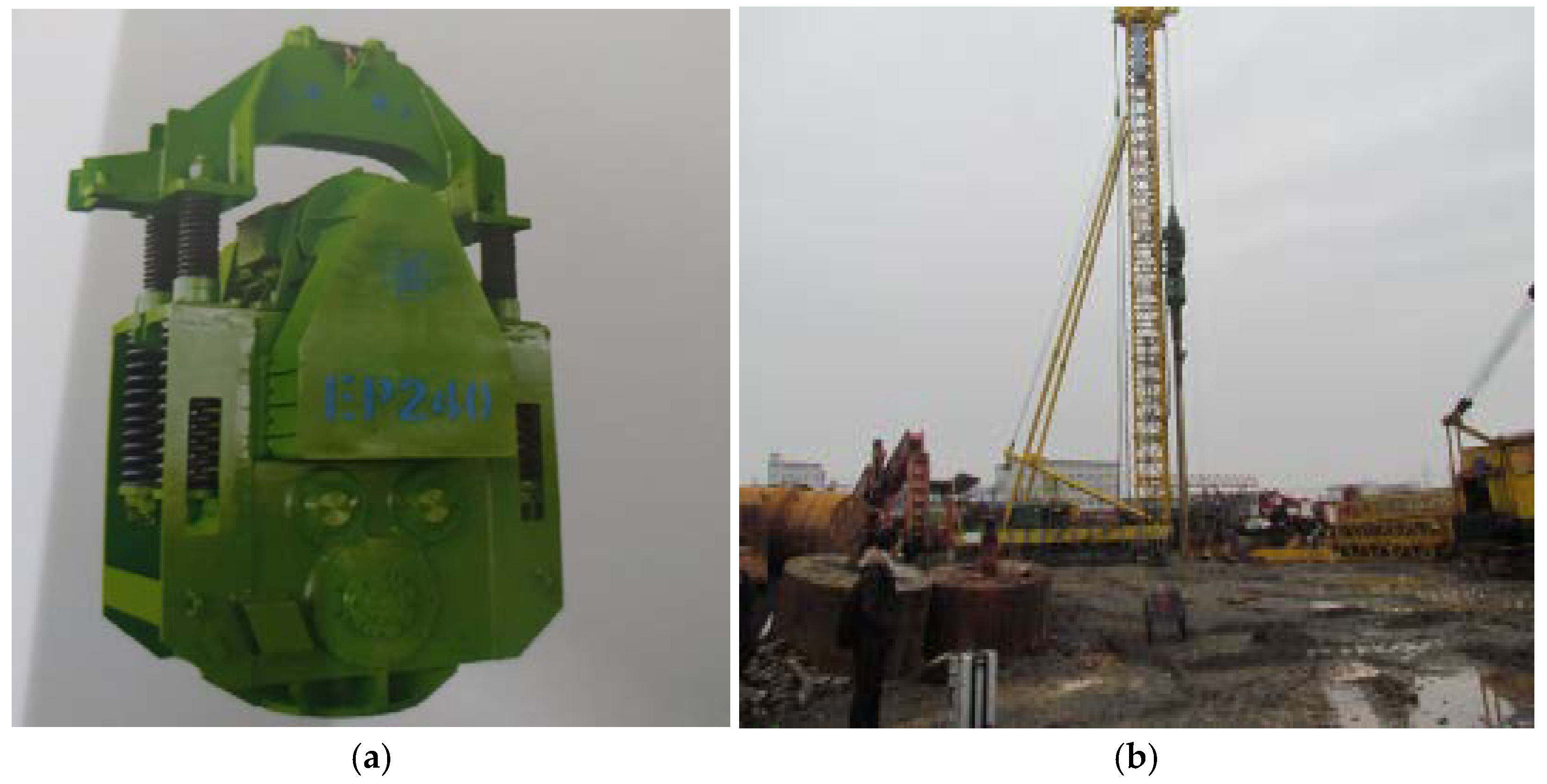
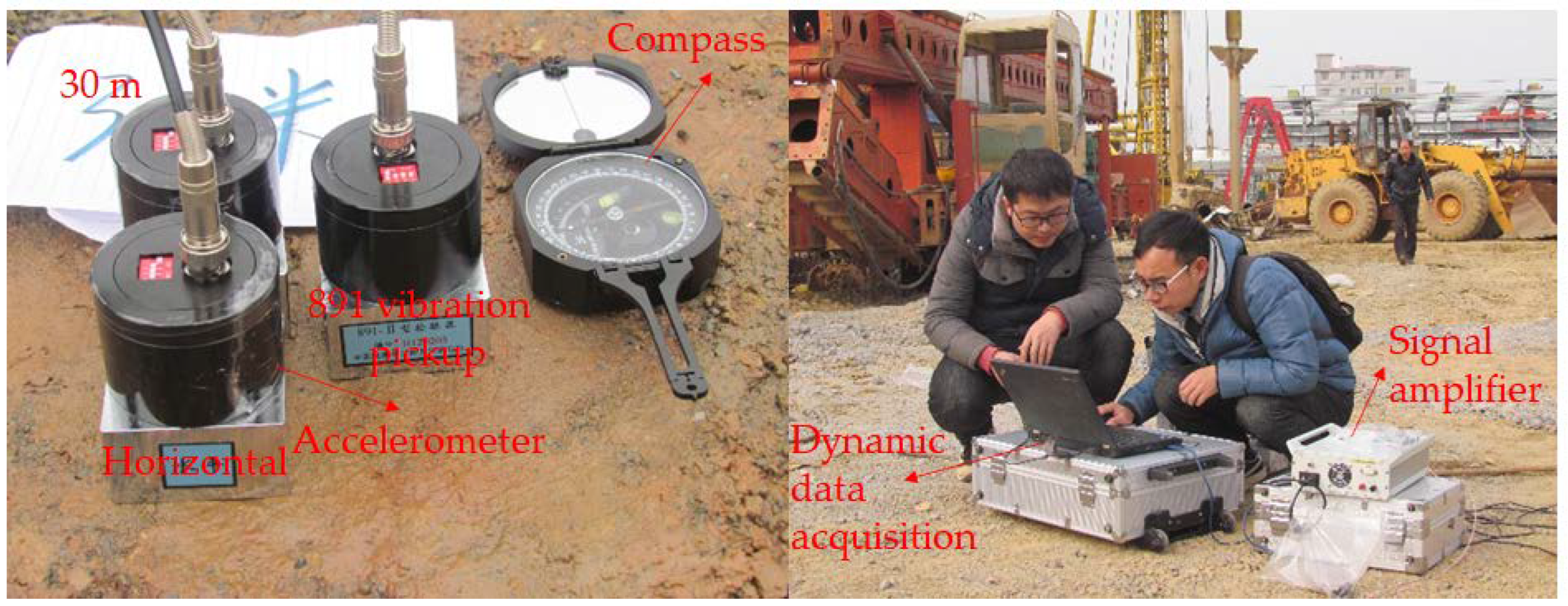
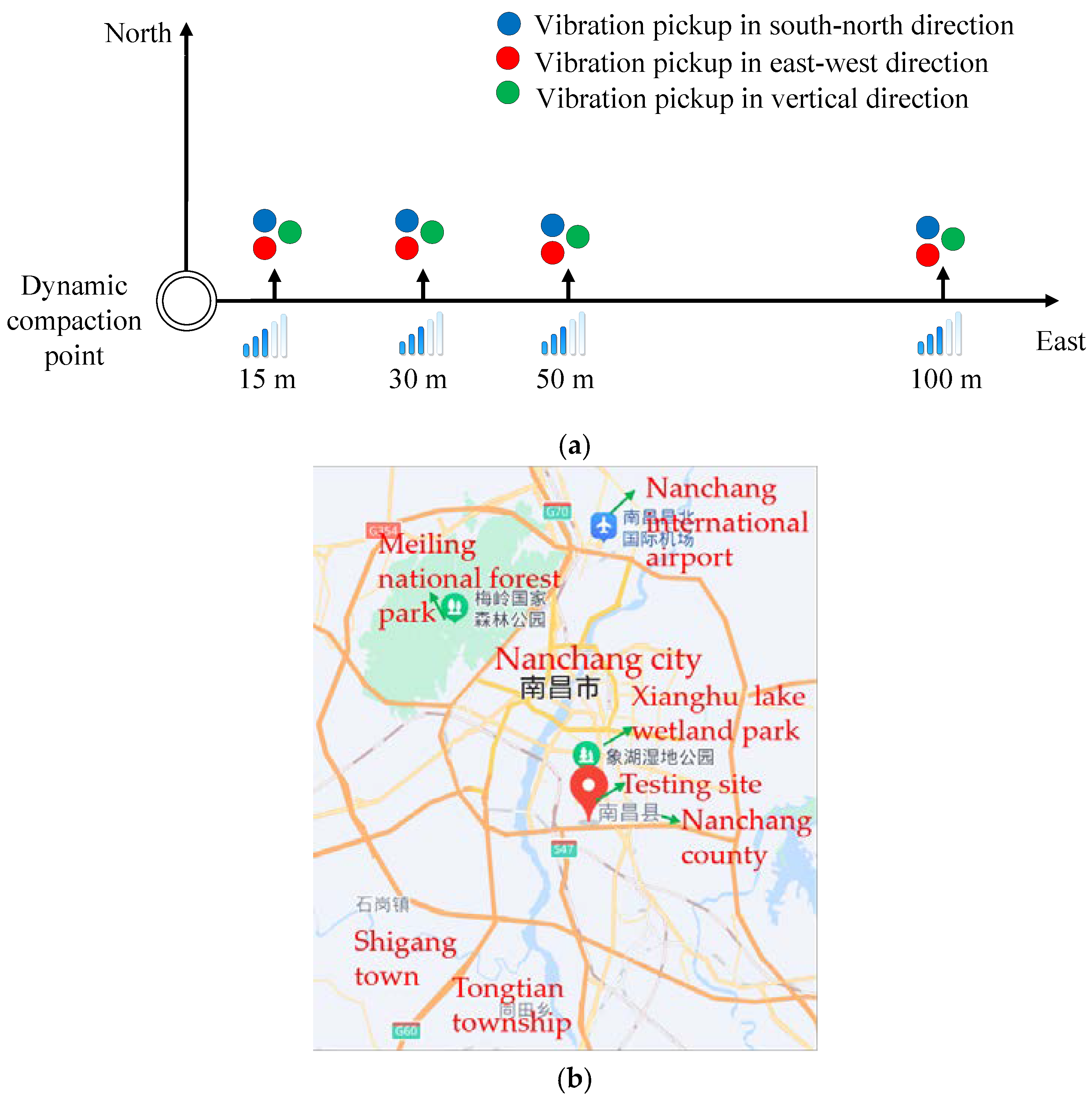
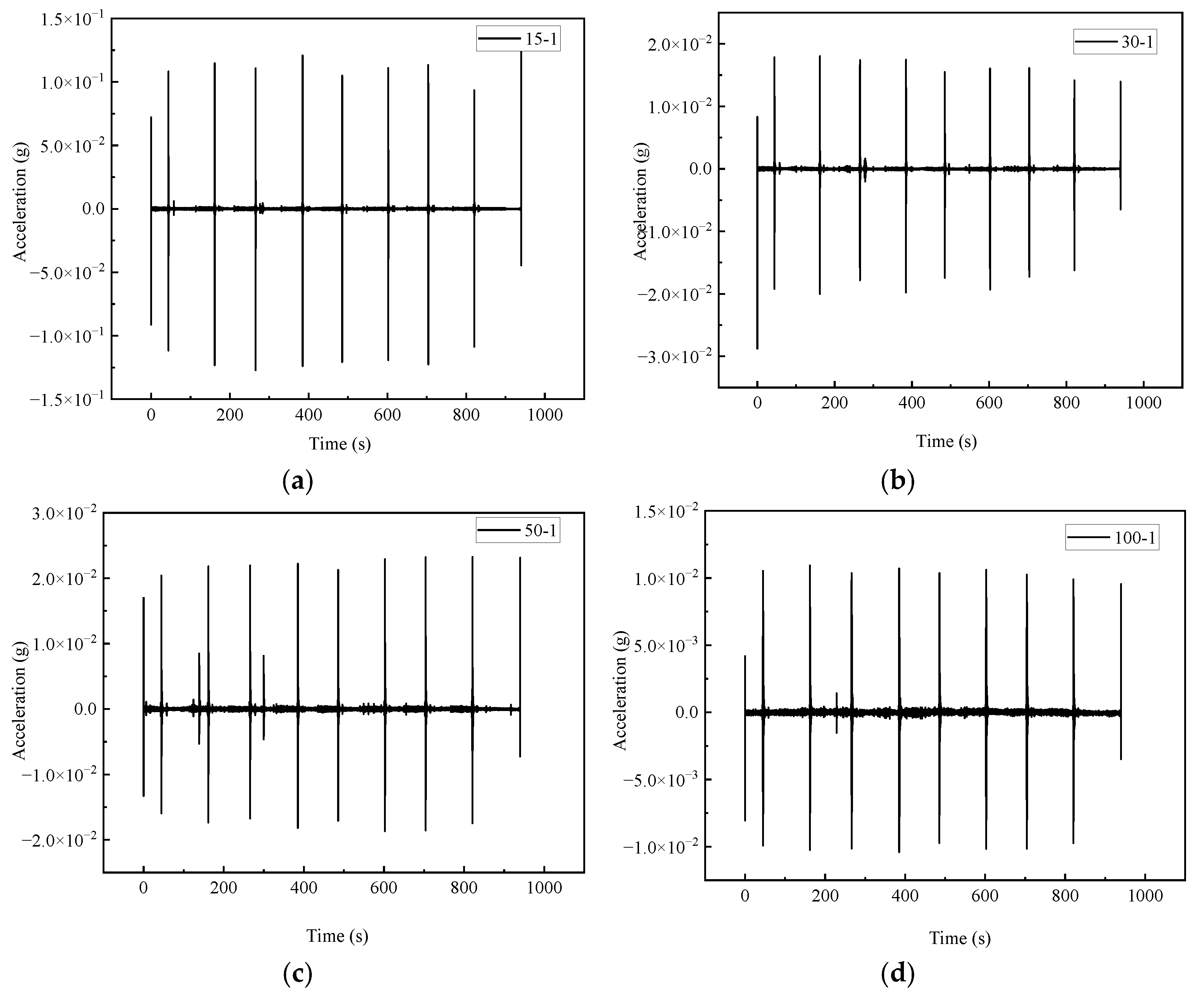
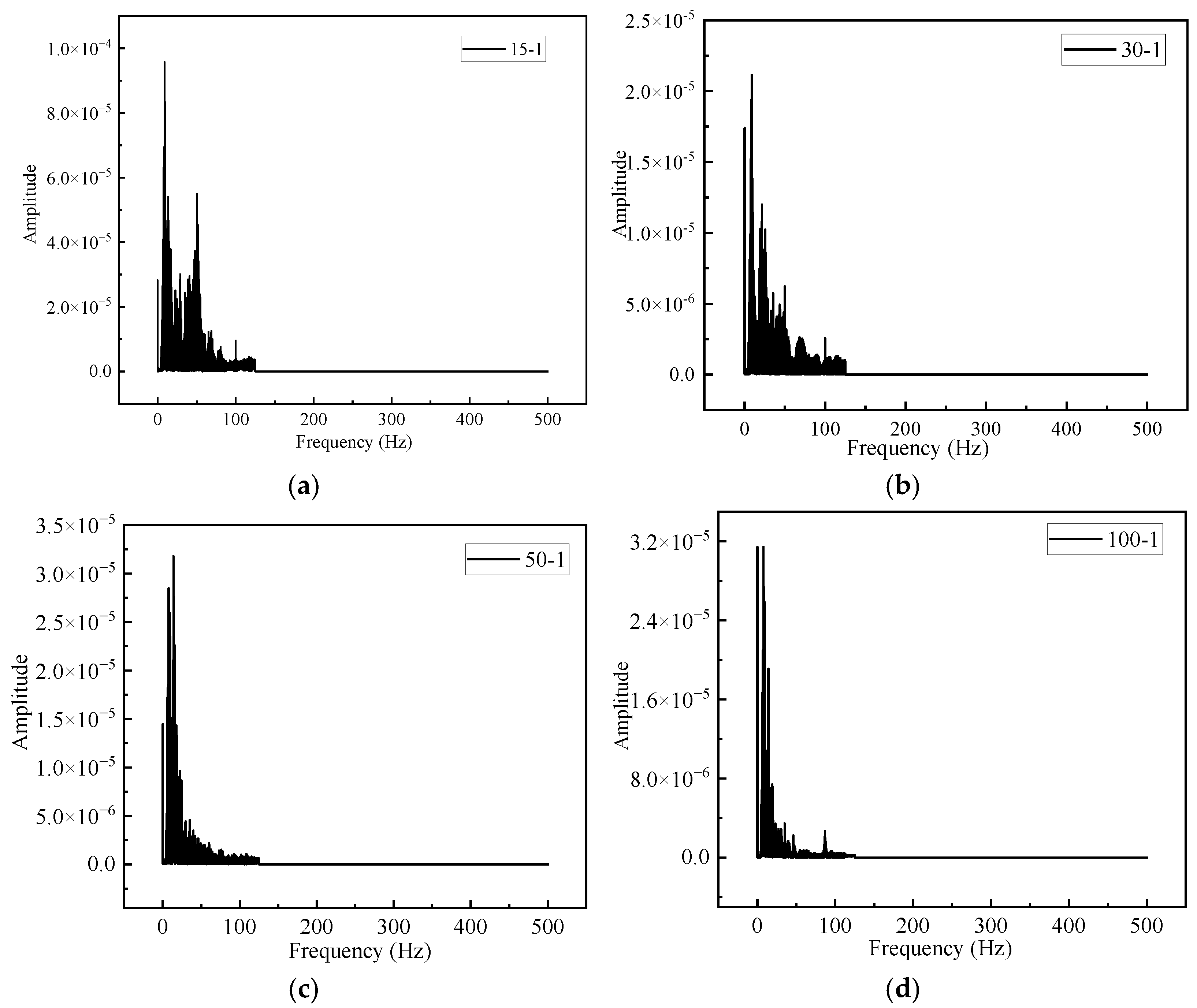
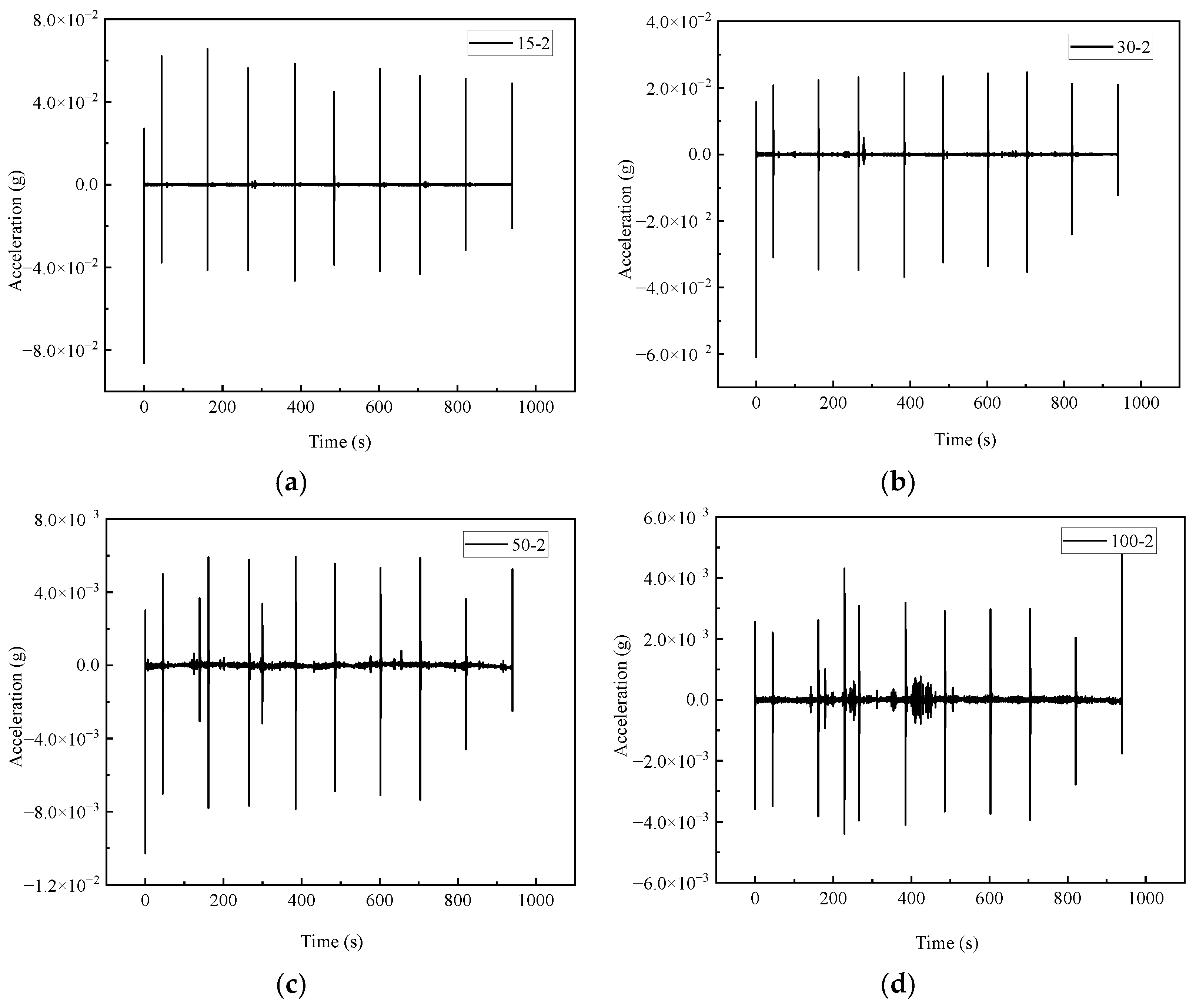
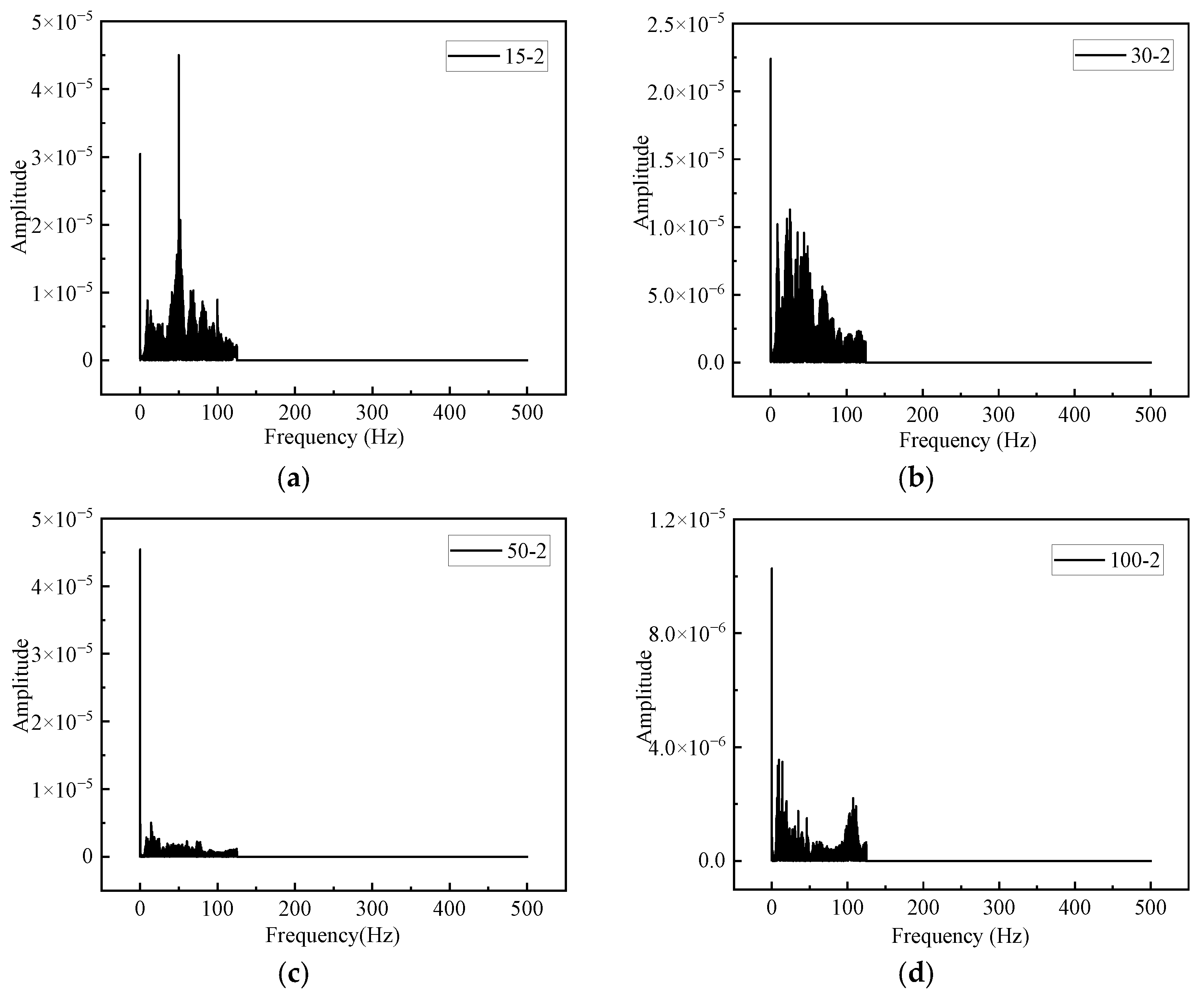
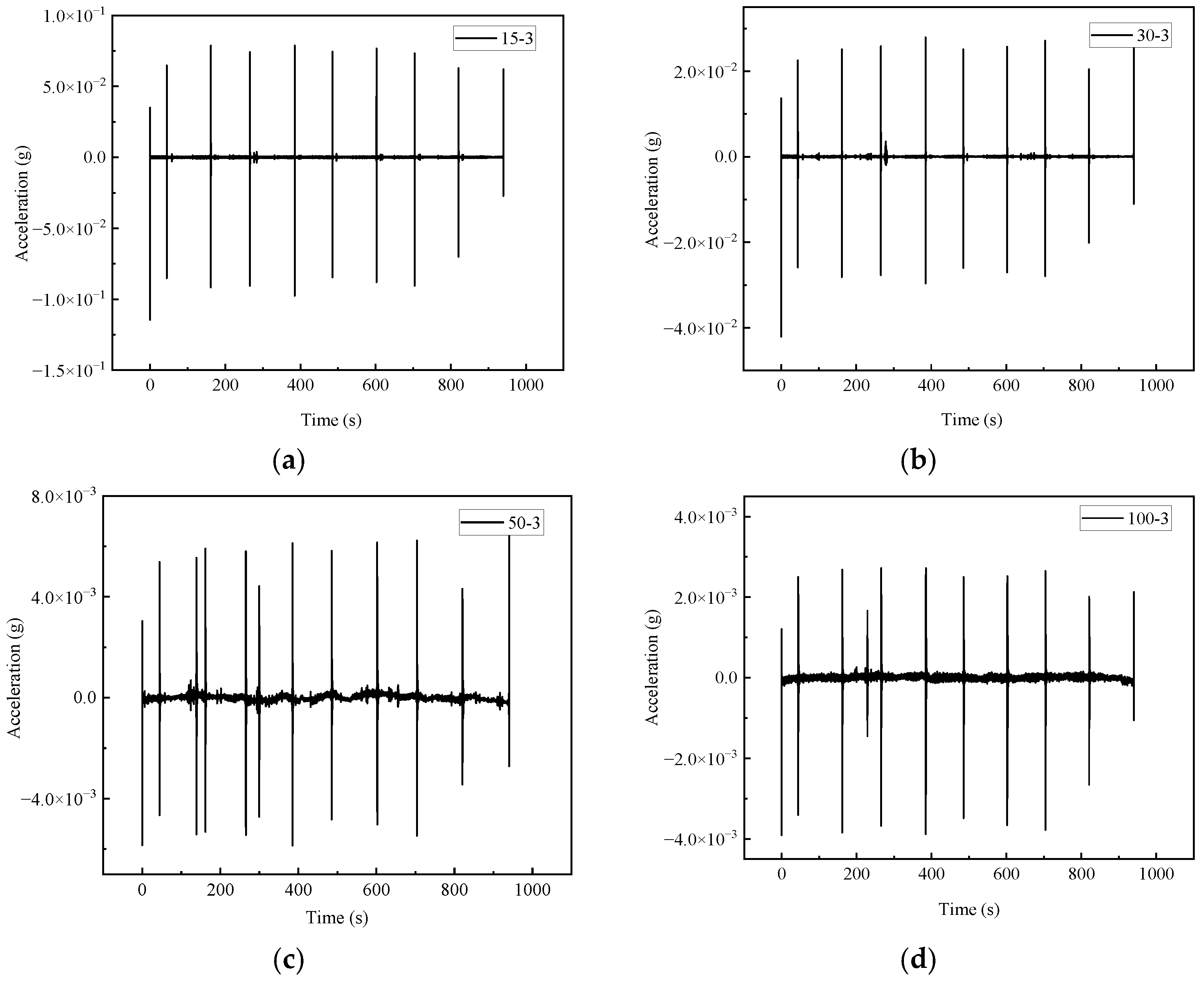
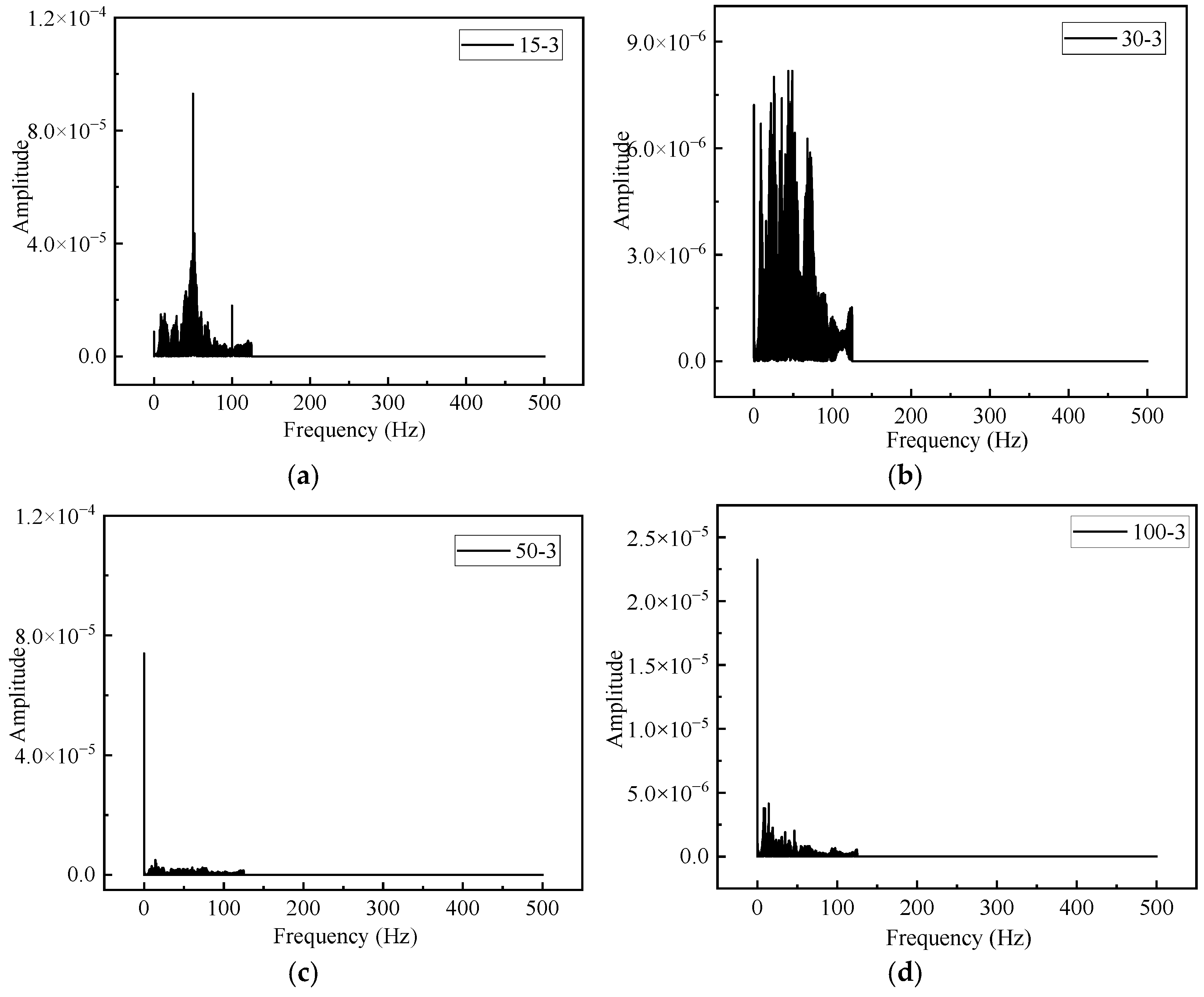
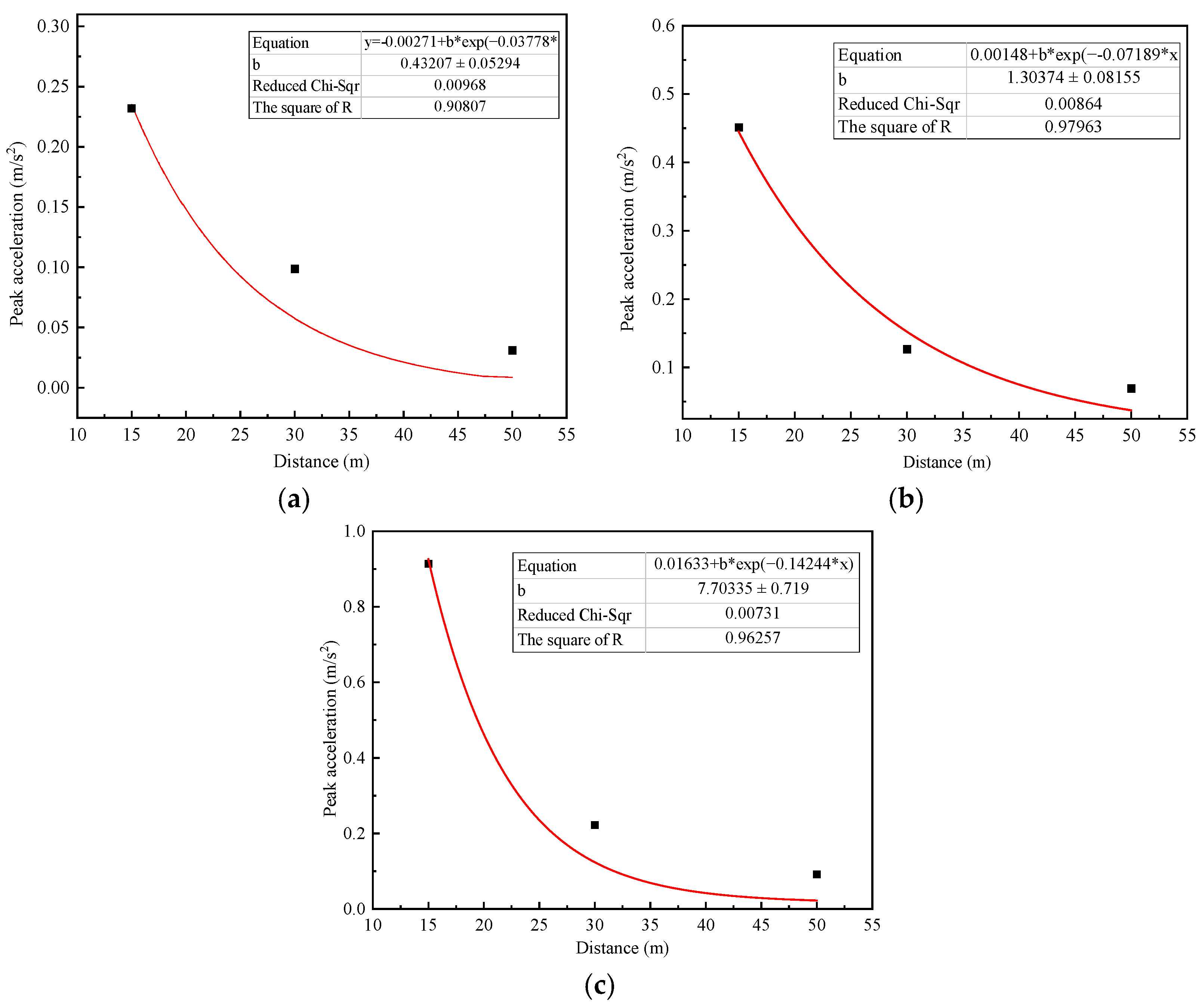
| Layer Number | Soil Name | Category | Thickness |
|---|---|---|---|
| ①-2 | Plain fill | Soft soil | 1.70 m |
| ③-1 | Silty clay | Medium soft soil | 1.80 m |
| ③-1-1 | Mucky soil | Medium soft soil | 2.00 m |
| ③-2 | Fine sand | Medium soft soil | 4.10 m |
| ③-3 | Medium sand | Medium soft soil | 2.60 m |
| ③-4 | Coarse sand | Medium hard soil | 1.80 m |
| ③-5 | Gravel sand | Medium hard soil | 10.00 m |
| ③-6 | Round gravel | Medium hard soil | 9.40 m |
| ⑤-1-3 | Moderately weathered argillaceous siltstone | Soft rock | 4.60 m |
| ⑤-4-2 | Moderately weathered calcareous mudstone | Soft rock | 2.90 m |
| Type | Electric Shock Power | Static Eccentric Moment | Maximum Vibration Frequency | Exciting Force | Vibration Mass |
|---|---|---|---|---|---|
| EP240 | 180 kW | 1500 N·m | 860 r/min | 124 ton | 13.320 kg |
| DFTVS | Vertical Direction | East-West Direction | South-North Direction | |||
|---|---|---|---|---|---|---|
| Peak Acceleration | Peak Velocity | Peak Acceleration | Peak Velocity | Peak Acceleration | Peak Velocity | |
| (m/s2) | (m/s) | (m/s2) | (m/s) | (m/s2) | (m/s) | |
| 15 m | 0.128872 | 0.006957 | 0.08639 | 0.005853 | 0.1145 | 0.006109 |
| 30 m | 0.02878 | 0.00429 | 0.06101 | 0.00474 | 0.04209 | 0.003165 |
| 50 m | 0.02327 | 0.003584 | 0.01029 | 0.004634 | 0.006808 | 0.001288 |
| 100 m | 0.010935 | 0.002238 | 0.004863 | 0.002133 | 0.00391 | 0.001125 |
| Item | Regression Formula Verification | Correlation Coefficient |
|---|---|---|
| East-west acceleration | 0.908 | |
| South-north acceleration | 0.979 | |
| Vertical acceleration | 0.962 |
Publisher’s Note: MDPI stays neutral with regard to jurisdictional claims in published maps and institutional affiliations. |
© 2022 by the authors. Licensee MDPI, Basel, Switzerland. This article is an open access article distributed under the terms and conditions of the Creative Commons Attribution (CC BY) license (https://creativecommons.org/licenses/by/4.0/).
Share and Cite
Cheng, X.; Xu, X.; Bai, W.; Hu, Z.; Liang, H.; Cui, J. A Calculation Model for Vibration Effect Induced by Resonance-Free Vibratory Hammer Method. Buildings 2022, 12, 2204. https://doi.org/10.3390/buildings12122204
Cheng X, Xu X, Bai W, Hu Z, Liang H, Cui J. A Calculation Model for Vibration Effect Induced by Resonance-Free Vibratory Hammer Method. Buildings. 2022; 12(12):2204. https://doi.org/10.3390/buildings12122204
Chicago/Turabian StyleCheng, Xinjun, Xiang Xu, Wen Bai, Zhinan Hu, Haian Liang, and Jie Cui. 2022. "A Calculation Model for Vibration Effect Induced by Resonance-Free Vibratory Hammer Method" Buildings 12, no. 12: 2204. https://doi.org/10.3390/buildings12122204
APA StyleCheng, X., Xu, X., Bai, W., Hu, Z., Liang, H., & Cui, J. (2022). A Calculation Model for Vibration Effect Induced by Resonance-Free Vibratory Hammer Method. Buildings, 12(12), 2204. https://doi.org/10.3390/buildings12122204







